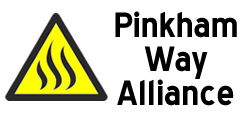The Pinkham Way Alliance is asking supporters to sign an online form supporting the Alliance's response to the current consultation about the North London Waste Plan. By signing, you confirm that you are happy for the PWA to represent your views. The deadline to add your name is 5pm on Tuesday 29th September 2015.
The Alliance has been campaigning to preserve an ecologically valuable green space adjacent to the North Circular Road and prevent construction of a waste processing facility on the site.
The Pinkham Way Alliance has issued the following information:

BELOW WE GIVE BRIEF DETAILS OF SOME OF THE POINTS TO BE INCLUDED IN THE PINKHAM WAY ALLIANCE SUBMISSION TO THE NORTH LONDON WASTE PLAN.
Some useful information:
NLWP – North London Waste Plan (a land use plan drawn up by the 7 N London Councils).
NLWA – North London Waste Authority (the waste disposal authority for the N London Councils).
Haringey Council is one of the 7 Councils, and is in addition the planning authority for the Pinkham Way site.
Pinkham Way is owned roughly two thirds by NLWA and one third by Barnet Council.
- The Pinkham Way site was included in the North London Waste Plan (NLWP) by Haringey Council before it had completed the site review recommended by the Local Plan Inspector in December 2012
- The available evidence from the Council’s own consultants indicated that the site was unsuitable for employment.
- The NLWP’s assessment of the site lacks objectivity, as insufficient weight is given to the nature conservation and open space value. There is no evidence that either Haringey Council or the NLWP has considered alternative uses.
- A flood risk assessment is required at Pinkham Way. The NLWP has failed to conduct one.
- The chronic A406 Pinkham Way congestion and its effect on the local secondary road system is now so acute as to demand detailed assessment by the NLWP; an assessment should not be left to be conducted by a potential developer as part of a planning application.
- The site is the only Site for Nature Conservation (SINC) in the NLWP. The NLWP must conform with the Local Plans of all member Councils. All member Councils state that SINCs, green infrastructure, priority habitats and endangered species should be protected. The site’s inclusion in the plan appears therefore to be an anomaly.
- The NLWP Sustainability Appraisal states that ‘the site is unlikely to be considered as previously developed land’. The London Plan says that land regarded as such ‘cannot be regarded as requiring development’.
- Were the land to be regarded by the Inspector examining the NLWP as brownfield, National Planning Policy Framework (NPPF) states that development should be avoided on brownfield land ‘of high environmental value’.
- The NLWP assessment of North London’s existing waste management capacity is inadequate and lacks detail compared to other plans.
- The NLWP’s estimate of the amount of waste that can be treated on a given area of land (‘throughput’, expressed in 000s of tons per hectare per year) is very low compared with other plans, especially other plans in London. The lower the throughput on a given area of land, the more land would be needed for management of a given amount of waste.
- The NLWP’s waste projections rely on a 30-year study conducted for the NLWA for its proposed new Edmonton plant. The consultants conducting the NLWA study expressed the strongest concerns on the amount of historical data available and the accuracy and worth of any forecast they might make, saying that ‘We would not normally advise forecasting for more than a very small number of years into the future on this basis’.
- They also point out, importantly, that ‘the analysis of a number of alternative scenarios show that waste arisings could vary significantly depending on the assumption made’
- The NLWA describes the study, surprisingly, as ‘a robust analysis of historical trends, and robust ... assumptions of what will happen to these trends in the future’. It made its decision based on a single scenario.
- The NLWP (which runs for 15 years until 2013) makes no mention of the uncertainty expressed by the consultants. Such uncertainty should mean , as the consultants suggest, that a comprehensive plan should develop a range of scenarios, including one of a long term decline in waste
- The NLWP neither mentions nor takes account of statistics from the previous several years, which show a steady decline in waste (12.8% since 2006/7) although the population of N London was rising (12.9% increase over the same period). Not to develop a projection from the existing context seems illogical and, in PWA’s view, unsound.
- The single scenario which the NLWP uses is the wrong one, and, in PWA’s view, the NLWP furthermore shows a fundamental misunderstanding of what it is trying to achieve in using it.
For more information see this page on the PWA website.